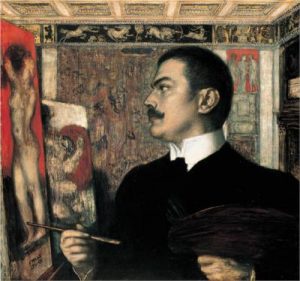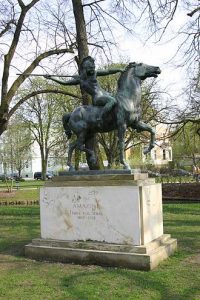Goering’s Carinhalle.

Carinhall was the country residence of Hermann Goering. It was built on a large hunting estate northeast of Berlin in the Schornheide forest, between the lakes Großdöllner See and Wuckersee in the north of Brandenburg.

Named in honour of his Swedish first wife, Carin Goering (1888–1931), the residence was constructed in stages from 1933 on a large scale, but in the manner of a hunting lodge. The main architect was Werner March , designer of the Olympic stadium in Berlin.


Her husband Hermann was to busy with the NSDAP  and didn’t sit at her bed when Carin died of heart failure on 17-10-1931, four days prior to her 43rd birthday. Carin first was buried in Löv, Sweden, but when Goering visited the grave in October 1933 and put a wreath, in the form of a swastika, on the grave, the graveside was destroyed. The gravestone with a swastika engraved was now engraved with the text, ” We the Swedish are insult by the desecration of tombs by the German Goering, let his former wife rest in peace and save us for the German propaganda “. Hermann Goering called the baronial hunting lodge he built from 1933 Carinhall,
and didn’t sit at her bed when Carin died of heart failure on 17-10-1931, four days prior to her 43rd birthday. Carin first was buried in Löv, Sweden, but when Goering visited the grave in October 1933 and put a wreath, in the form of a swastika, on the grave, the graveside was destroyed. The gravestone with a swastika engraved was now engraved with the text, ” We the Swedish are insult by the desecration of tombs by the German Goering, let his former wife rest in peace and save us for the German propaganda “. Hermann Goering called the baronial hunting lodge he built from 1933 Carinhall,

in her honour. It was there that he had her body re interred from her original grave in Sweden, in a funeral attended by Adolf Hitler (see Alois Hitler) (did you know).
On 10-04-1935, Carinhall was the venue for Goering’s wedding banquet with his second wife, Emmy Sonnemann.  Carinhall became the destination for many of Goering’s looted art treasures from across occupied Europe. The Reichsjägerhof, Goering’s smaller hunting lodge at Rominten in East Prussia, in the Rominten Heath, was known as “Emmyhall” after his second wife.
Carinhall became the destination for many of Goering’s looted art treasures from across occupied Europe. The Reichsjägerhof, Goering’s smaller hunting lodge at Rominten in East Prussia, in the Rominten Heath, was known as “Emmyhall” after his second wife.
To prevent Carinhall from falling into the hands of the advancing Red Army, the compound was blown up on 28 April 1945 at Goering’s orders by a Luftwaffe demolition squad. The art treasures were evacuated beforehand to Berchtesgaden




Only the monumental entrance gates, a few foundation structures, and decorative stones remain from the building. A bronze statue by Franz von Stuck

 , Kämpfende Amazone (1897), once at Carinhall, is now at Eberswalde.
, Kämpfende Amazone (1897), once at Carinhall, is now at Eberswalde.

In 1999, new interest was sparked by the book Görings Reich: Selbstinszenierungen in Carinhalle which saw treasure hunters drawn to the ruins, and concerns raised about the site becoming a neo-Nazi “shrine”. The state government of Brandenburg ordered the remains of the tomb of Goering’s wife to be demolished.













Leave a Reply